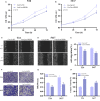Oestrogen promotes tumorigenesis of bladder cancer by inducing the enhancer RNA-eGREB1
- PMID: 30252203
- PMCID: PMC6237589
- DOI: 10.1111/jcmm.13861
Oestrogen promotes tumorigenesis of bladder cancer by inducing the enhancer RNA-eGREB1
Abstract
In recent years, studies have shown that enhancer RNAs (eRNAs) can be transcribed from enhancers. Increasing evidence has revealed that eRNAs play critical roles in the development of various cancers. Oestrogen-associated eRNAs are closely related to breast cancer. In view of the gender differences in bladder cancer (BCa), we suppose that oestrogen-associated eRNAs are also involved in tumorigenesis of BCa. In our study, we first demonstrated that eGREB1 derived from the enhancer of an oestrogen-responsive gene-GREB1 was up-regulated in BCa tissues, and the expression level of eGREB1 is positively associated with the histological grade and TNM stage of BCa. Knockdown of eGREB1 by CRISPR-Cas13a could inhibit cell proliferation, migration and invasion and induce apoptosis in BCa cells T24 and 5637. Besides, we exhibited the promoting effect of oestrogen on BCa cells. What's more, down-regulation of eGREB1 could improve the malignant biological characteristics of BCa cells induced by oestrogen. In conclusion, our data indicated that eGREB1 plays oncogenic role and oestrogen may promote the occurrence and progression of BCa by inducing eGREB1 production. Our findings provide new insights into the prevention of BCa and develop a novel therapeutic target for the treatment of BCa.
Keywords: bladder cancer; eGREB1; enhancer RNAs; oestrogen.
© 2018 The Authors. Journal of Cellular and Molecular Medicine published by John Wiley & Sons Ltd and Foundation for Cellular and Molecular Medicine.
Figures




Similar articles
-
Enhancer RNA - P2RY2e induced by estrogen promotes malignant behaviors of bladder cancer.Int J Biol Sci. 2018 Jul 27;14(10):1268-1276. doi: 10.7150/ijbs.27151. eCollection 2018. Int J Biol Sci. 2018. PMID: 30123075 Free PMC article.
-
High expression of TMEM40 is associated with the malignant behavior and tumorigenesis in bladder cancer.J Transl Med. 2018 Jan 19;16(1):9. doi: 10.1186/s12967-017-1377-3. J Transl Med. 2018. PMID: 29351801 Free PMC article.
-
High expression of enhancer RNA MARC1 or its activation by DHT is associated with the malignant behavior in bladder cancer.Exp Cell Res. 2018 Sep 15;370(2):303-311. doi: 10.1016/j.yexcr.2018.06.032. Epub 2018 Jun 28. Exp Cell Res. 2018. Retraction in: Exp Cell Res. 2024 Sep 1;442(1):114223. doi: 10.1016/j.yexcr.2024.114223. PMID: 29964053 Retracted.
-
The current research status of enhancer RNAs.Yi Chuan. 2017 Sep 20;39(9):784-797. doi: 10.16288/j.yczz.17-010. Yi Chuan. 2017. PMID: 28936977 Review.
-
The emerging role of super enhancer-derived noncoding RNAs in human cancer.Theranostics. 2020 Sep 2;10(24):11049-11062. doi: 10.7150/thno.49168. eCollection 2020. Theranostics. 2020. PMID: 33042269 Free PMC article. Review.
Cited by
-
Sex Hormone Receptor Signaling in Bladder Cancer: A Potential Target for Enhancing the Efficacy of Conventional Non-Surgical Therapy.Cells. 2021 May 11;10(5):1169. doi: 10.3390/cells10051169. Cells. 2021. PMID: 34064926 Free PMC article. Review.
-
Socioeconomic disparities between oral cavity cancer patients in Germany.Front Public Health. 2022 Jul 22;10:831479. doi: 10.3389/fpubh.2022.831479. eCollection 2022. Front Public Health. 2022. PMID: 35937274 Free PMC article.
-
The Role of Estrogen Receptors in Urothelial Cancer.Front Endocrinol (Lausanne). 2021 Mar 16;12:643870. doi: 10.3389/fendo.2021.643870. eCollection 2021. Front Endocrinol (Lausanne). 2021. PMID: 33796076 Free PMC article. Review.
-
Enhancer RNA LINC00242-Induced Expression of PHF10 Drives a Better Prognosis in Pancreatic Adenocarcinoma.Front Oncol. 2022 Jan 20;11:795090. doi: 10.3389/fonc.2021.795090. eCollection 2021. Front Oncol. 2022. PMID: 35127503 Free PMC article.
-
Enhancer RNAs: transcriptional regulators and workmates of NamiRNAs in myogenesis.Cell Mol Biol Lett. 2021 Feb 10;26(1):4. doi: 10.1186/s11658-021-00248-x. Cell Mol Biol Lett. 2021. PMID: 33568070 Free PMC article. Review.
References
-
- Torre LA, Bray F, Siegel RL, et al. Global cancer statistics, 2012. CA Cancer J Clin. 2015;65:87‐108. - PubMed
-
- Sorahan T. Bladder cancer risks in workers manufacturing chemicals for the rubber industry. Occup Med. 2008;58:496‐501. - PubMed
-
- Richardson K, Band PR, Astrakianakis G, Le ND. Male bladder cancer risk and occupational exposure according to a job‐exposure matrix‐a case‐control study in British Columbia, Canada. Scand J Work Environ Health. 2007;33:454‐464. - PubMed
-
- Parkin DM. The global health burden of infection‐associated cancers in the year 2002. Int J Cancer. 2006;118:3030‐3044. - PubMed
Publication types
MeSH terms
Substances
LinkOut - more resources
Full Text Sources
Other Literature Sources
Medical

